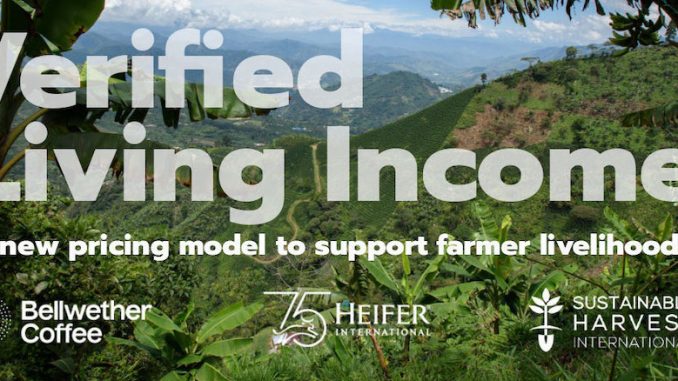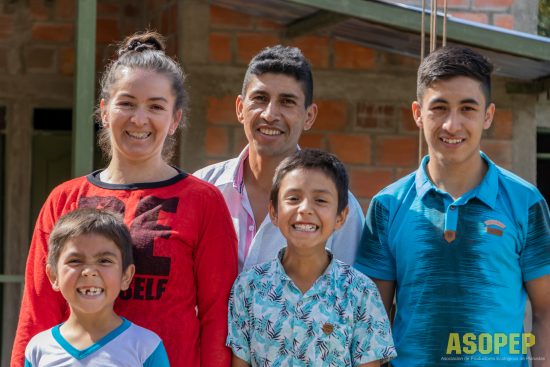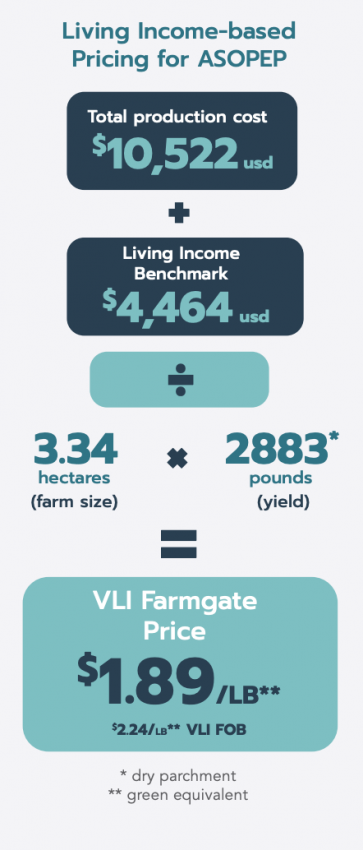
Industry members team up to pay more than the cost of production for green coffee.
BY KATRINA YENTCH
BARISTA MAGAZINE ONLINE
Photos courtesy of Bellwether Coffee
In times of crisis, we’ve witnessed the greater coffee community band together to help those impacted, whether it be through donating essential supplies after a natural disaster or providing additional income workshops for farmers. And so, the ongoing efforts to secure farmer income beyond the volatile commodity price is growing that much stronger; the Verified Living Income tool is the latest project to tackle this.
Verified Living Income (VLI) is a data initiative to determine what the true costs are that coffee farmers affiliate with not only coffee production, but also to maintain a quality standard of living. The pilot study was an effort spearheaded by Bellwether Coffee with Sustainable Harvest, the Latin American and Caribbean Network of Fair Trade Small Producers and Workers (CLAC), and the Tolima, Colombia-based cooperative ASOPEP. The four entities worked with nonprofit Heifer International to gather data from 38 farmers with ASOPEP and other partner organizations to deliver the hard facts of just how much money it costs to run a farm and a family at the same time.

When asked what inspired Bellwether to launch this initiative, senior sustainability manager Grayson Caldwell explains, “We were basing pricing structures on the best available information, building partnerships with value-aligned specialty-coffee importers, and paying competitive prices. But were we really paying an equitable, sustainable price for coffee? … I came across the living income community of practice and started to explore what it would really mean to pay a living income-based price.”
Bellwether reached out to Sustainable Harvest in particular after conducting an origin visit together to ASOPEP, who also expressed excitement in finding ways to advance their cooperative. “Sustainable Harvest is a mission-driven specialty-coffee importer that is very values-aligned with Bellwether,” says Grayson. “Their relationship coffee model with deep producer relationships, origin staff, and expertise on data collection was a natural fit for implementing a pilot at origin.”
Verified Living Income used several factors to measure a standard of comfort that meets the Living Income Benchmark, which includes:
- A nutritious, low-cost diet
- Decent housing
- Other basic needs (communication, transportation, clothing, health care, education, arts/culture)
- Unavoidable unexpected costs
The cost of living per year, with these factors in mind, came out to $4,464/person.
The full white paper breaks down every aspect of the factors that determine the cost of production and living, from yields per hectare of land to the farm gate price of coffee. Bellwether defines this as that which “represents the money producers receive at the ‘farm’s gate’ for the sale of product before additional transportation, milling, processing, warehousing, and other costs. FOB contract prices roll up all those extra expenses.” For this reason, VLI uses farm gate price as the most transparent measure of what farmers get.
Summarized, that cost comes out to $10,522 USD, which means the price of their green coffee needs to be $1.89 USD/lb.

By Verified Living Income standards, Bellwether Coffee, which offers a green coffee eCommerce portal to owners of their roasters, was surprised to learn that based on their current buying practices, they were actually 20% below the rate that they should have been paying per pound. This prompted another contract drafted for 2021 that raised their pricing by 20% to get closer to the standard.
“To create a more fair and sustainable industry, producer livelihood must be the starting point for green coffee prices,” confirms Bellwether in a blog post explaining the initiative. “Buyers can no longer be ‘price setters’ and producers ‘price takers.’ This will require cooperation from stakeholders at every level of the value chain—and it can be done.”
To achieve this combined effort, Bellwether encourages both farmers and cooperatives to attain tools for economic empowerment and better financial management. Along with this, they suggest a commitment by roasters and other coffee organizations to incorporate the cost of living into their considerations. One example of practicing this consideration is when it comes to actions like setting contracts with corporations who can first promise buying practices approved by VLI.
“If broadly adopted, this will allow the industry to move from ambitious talks and ambiguous commitments to implement concerted, clearly defined actions to address the fundamental disparities that threaten the industry’s longevity,” explains Grayson.

